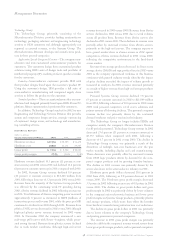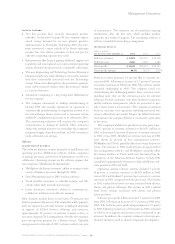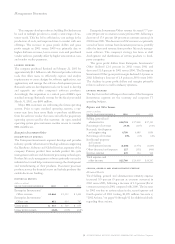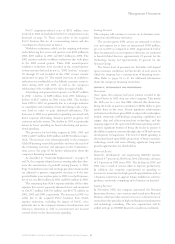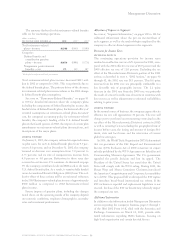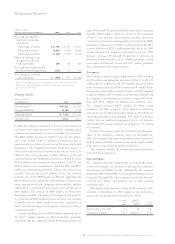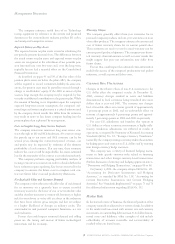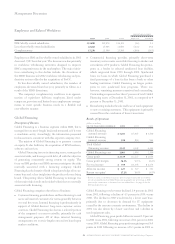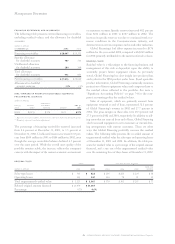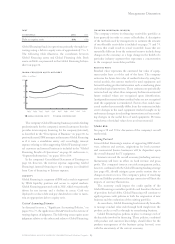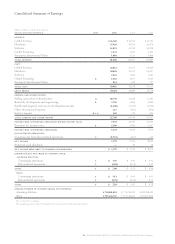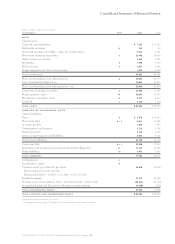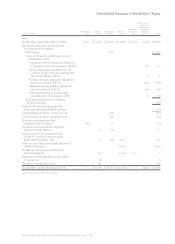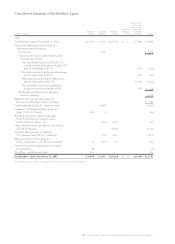IBM 2002 Annual Report Download - page 60
Download and view the complete annual report
Please find page 60 of the 2002 IBM annual report below. You can navigate through the pages in the report by either clicking on the pages listed below, or by using the keyword search tool below to find specific information within the annual report.
Management Discussion
58 international business machines corporation and Subsidiary Companies
The company estimates useful lives of its Technology
Group equipment by reference to the current and projected
dynamics in the semiconductor industry, product life cycles,
and anticipated competitor actions.
Expected Return on Plan Assets
The expected return on plan assets is used in calculating the
net periodic pension (income)/cost. The differences between
the actual return on plan assets and expected return on plan
assets are recognized in the calculation of net periodic pen-
sion (income)/cost over five years and, over the long term,
typically has not had a material effect on the Consolidated
Financial Statements.
As described on pages 95 and 96, if the fair value of the
pension plan’s assets are below the plan’s ABO, the company
will be required to record a minimum liability. In some situ-
ations, the pension asset must be partially reversed through a
charge to stockholders’ equity. If the ABO in excess of plan
assets is large enough, the company may be required, by law,
to make an additional contribution to the pension plan. While
the amount of funding is not dependent upon the company’s
expected long-term return assumption, the company’s esti-
mated expected return on plan assets is a critical estimate used
by the company. Actual results that differ from the estimates
may result in more or less future company funding into the
pension plans than is planned by management.
Costs to Complete Long-Term Service Contracts
The company enters into numerous long-term service con-
tracts through its SO and BCS businesses. SO contracts range
for periods up to ten years and BCS contracts can be for
several years. During the contractual period, revenue, cost
and profits may be impacted by estimates of the ultimate
profitability of each contract. If at any time, these estimates
indicate the contract will be unprofitable, the entire estimated
loss for the remainder of the contract is recorded immediately.
The company performs ongoing profitability analyses of
its long-term services contracts in order to check whether the
latest estimates require updating. Key factors reviewed by the
company to estimate the future costs to complete each con-
tract are future labor costs and productivity efficiencies.
Net Realizable Value and Customer Demand
The company reviews the net realizable value of and demand
for its inventory on a quarterly basis to ensure recorded
inventory is stated at the lower of cost or net realizable value
and that obsolete inventory is written off. Inventory at higher
risk for writedowns or write-offs are those in the industries
that have lower relative gross margins and that are subject
to a higher likelihood of changes in industry cycles. The
semiconductor and personal computer businesses are two
such industries.
Factors that could impact estimated demand and selling
prices are the timing and success of future technological
innovations and the economy.
Warranty Claims
The company generally offers three-year warranties for its
personal computer products and one-year warranties on most
of its other products. The company estimates the amount and
cost of future warranty claims for its current period sales.
These estimates are used to record accrued warranty cost for
current period product shipments. The company uses histor-
ical warranty claim information as well as recent trends that
might suggest that past cost information may differ from
future claims.
Factors that could impact the estimated claim information
include the success of the company’s productivity and quality
initiatives, as well as parts and labor costs.
Currency Rate Fluctuations
Changes in the relative values of non-U.S. currencies to the
U.S. dollar affect the company’s results. At December 31,
2002, currency changes resulted in assets and liabilities
denominated in local currencies being translated into more
dollars than at year-end 2001. The currency rate changes
had a favorable effect on revenue growth of approximately
1 percentage point in 2002, and an unfavorable effect on
revenue of approximately 4 percentage points and approxi-
mately 3 percentage points in 2001 and 2000, respectively.
For non-U.S. subsidiaries and branches that operate in
U.S. dollars or whose economic environment is highly infla-
tionary, translation adjustments are reflected in results of
operations, as required by Statement of Financial Accounting
Standards (SFAS) No. 52, “Foreign Currency Translation.”
Generally, the company manages currency risk in these entities
by linking prices and contracts to U.S. dollars and by entering
into foreign currency hedge contracts.
The company uses a variety of financial hedging instru-
ments to limit specific currency risks related to financing
transactions and other foreign currency-based transactions.
Further discussion of currency and hedging appears in note l,
“Derivatives and Hedging Transactions,” on pages 84 to 86.
On January 1, 2001, the company adopted SFAS No. 133,
“Accounting for Derivative Instruments and Hedging
Activities,” as amended by SFAS No. 138, “Accounting for
Certain Derivative Instruments and Certain Hedging
Activities.” See “Standards Implemented,” on pages 75 and 76
for additional information regarding SFAS No. 133.
Market Risk
In the normal course of business, the financial position of the
company routinely is subjected to a variety of risks. In addition
to the market risk associated with interest rate and currency
movements on outstanding debt and non-U.S. dollar denom-
inated assets and liabilities, other examples of risk include
collectibility of accounts receivable and recoverability of
residual values on leased assets.


